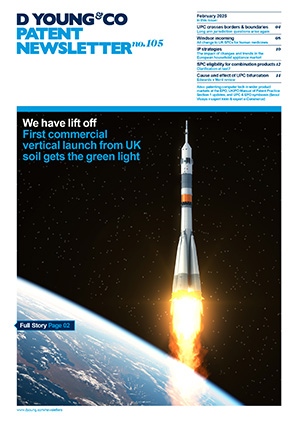G 2/21: patent plausibility, technical effect, inventive step and AI inventions
Artificial intelligence (AI) has developed at a very rapid pace over the last decade. AI inventions are now having a significant impact across all areas of technology. Indeed, there is great excitement and anticipation concerning the role AI will play in the coming decade.
At the European Patent Office (EPO) AI inventions are considered to be a type of computer implemented invention (CII). CII inventions (and thus AI inventions) must provide a technical solution to a technical problem in order to be eligible for patent protection.
In G 2/21, the Enlarged Board of Appeal provided certain criteria concerning whether an applicant can rely on an alleged technical effect. However, the Enlarged Board of Appeal acknowledged that the outcome of the application of those criteria may well be influenced by the technical field of the invention.
When the technical effect arising from a distinguishing feature of the invention depends on the use of AI, the question arises whether the applicant can rely on an alleged technical effect during the assessment of inventive step.
Technical effect and inventive step
In order to be patentable an invention must be new (that is, it must have one or more novel features compared to what is already known (the prior art)). The invention must also involve an inventive step.
At the EPO inventive step is assessed using the so-called problem-solution approach.
Under the problem-solution approach a comparison is made of the claimed invention with the closest prior art. Any distinguishing features (novel features) of the claimed invention over the closest prior art are identified. Then, the technical effect achieved by these distinguishing features is determined.
Based on the technical effect provided by these distinguishing technical features, an objective technical problem is formulated.
An inventive step will be acknowledged if the claimed solution to the objective technical problem (the use of the distinguishing technical features) would not have been obvious to the skilled person, in view of the teachings of the cited prior art.
If a claimed invention is both novel and inventive (and if it satisfies certain other patentability requirements) then a patent will be granted.
When filing an application it can be difficult to know which feature or features will be relied upon in the assessment of inventive step, and what technical effect is provided by these features compared to the cited prior art.
Accordingly, an applicant may wish to use evidence produced after the application has been filed, in order to support the technical effect provided by a feature of the claimed invention, but to what extent is this possible?
G 2/21: plausibility of technical effect
In G 2/21, the Enlarged Board of Appeal addressed the question of whether an applicant may rely on post-filed evidence (evidence filed after the date of filing of the application) during assessment of inventive step.
For an AI invention, an applicant may wish to use post-filed evidence showing that a feature improves the speed or efficiency of a process or computation compared to the prior art.
The assessment of inventive step is made at the effective date of the patent, on the basis of the information in the patent together with the common general knowledge available to the skilled person.
Nevertheless, a patent applicant (or proprietor) may rely upon a technical effect for inventive step if the skilled person, having the common general knowledge in mind, and based on the application as originally filed, would consider said effect as being encompassed by the technical teaching and embodied by the same originally disclosed invention (see G 2/21).
Indeed, in G 2/21, the Enlarged Board of Appeal confirmed that the mere fact that evidence supporting the technical effect is filed after the patent was filed, is not in itself sufficient reason to disregard that evidence.
This means that an applicant may be able to rely on post-filed evidence in order to support a technical effect, provided that the skilled person would consider that effect to be encompassed by the originally disclosed invention.
However, the Enlarged Board of Appeal acknowledged that the outcome of these tests (or criteria) may well to some extent be influenced by the technical field of the claimed invention.
Technical effect and AI inventions
An AI invention may be considered as a computational model or program which is trained on training data, such that it can recognise patterns or trends in the training data. Once trained, the AI model can then be used in order to make predictions on previously unseen data.
If the distinguishing feature between the claimed invention and the cited prior art is the use of a certain type of AI, it may be quite straight forward to demonstrate that the claimed invention provides a technical effect over the cited prior art. This is because the advantages associated with the use of an AI model may be considered to be quite well established.
However, a more common situation may be a situation where the distinguishing feature of the invention relates to the way in which the model is trained, and/or the training data which is used during training of the model. In a situation such as this, it may not be as readily apparent to the skilled person whether a certain effect is encompassed by the technical teaching, and embodied by the same originally disclosed invention. As such, an applicant should consider providing data within the application as filed in order to demonstrate the technical effect provided by the use of a specific training mechanism and/or a particular set of training data.
Even if this data is not provided with the application as filed, in view of G 2/21 it may still be possible to provide post-filed evidence in order to support a technical effect, provided that the skilled person would consider said effect as being encompassed by the originally disclosed invention. Thus, when filing an application, the applicant should ensure that the technical effect associated with each aspect of the invention is clearly identified.
Therefore, for AI inventions, it is very important not simply to rely on generalised technical effects related to the use of AI to a particular situation, but also to explain different technical effects achieved by more specific features of the invention.
Interplay with sufficiency of disclosure
As noted, in G 2/21, the Enlarged Board of Appeal outlined criteria under which post-filed evidence may be used in order to support a technical effect in the assessment of inventive step. However, it is important to make a distinction between the use of post-filed evidence to support a technical effect for inventive step, compared to the use of post-filed evidence to support sufficiency of disclosure.
Indeed, post-published documents may only be used as evidence that the disclosure is reproducible (to support sufficiency of disclosure) without undue burden under certain (quite limited) circumstances.
In the context of AI inventions, this means that it is very important to disclose the training data and/or model parameters required to reproduce the invention and achieve the technical effect across the whole scope of the claims within the application as filed.
This requirement has been demonstrated by the Board of Appeal in recent decisions T 0161/18 and T 1191/19, where the respective applications were refused for lack of sufficiency of disclosure, on the basis that insufficient details concerning the data required to train the model had been provided.
The scope for relying on post-filed evidence is much narrower under sufficiency of disclosure, compared to its use under inventive step. Therefore, a patent application should be drafted to ensure that sufficient details regarding the AI model are provided within the application as filed.
Conclusion
An applicant filing a patent application for an invention which relies on AI should ensure that the technical effect achieved by different features of the claimed invention are clearly explained, such that it will be possible to use these features in support of an inventive step.
Furthermore, while post-filed evidence may, in some situations, be used in order to support a technical effect which can be used in the assessment of inventive step, it will likely be very difficult to use post-filed evidence to demonstrate sufficiency of disclosure. Therefore, an applicant must ensure that there is sufficient detail of the AI model (in particular, the training data used to train the AI model) within the application as filed, so as to enable the skilled person to implement the claimed invention across the whole scope of the claim.
Useful links
- G 0002/21 (Reliance on a purported technical effect for inventive step (plausibility)), EPO Board of Appeal, 23 March 2023: dycip.com/g-0002-21-epo-plausibility
- T 0161/18, EPO Board of Appeal, 12 May 2020: dycip.com/t-0161-18
- T 1191/19, EPO Board of Appeal, 01 April 2022: dycip.com/t-1191-19


